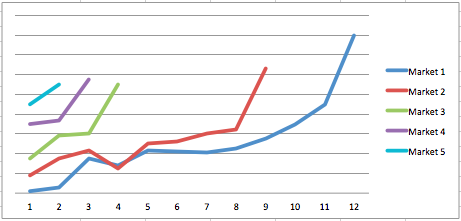Non-Linear Competition: The Fear Of The Unknown

In a non-linear competitive landscape, two or more organizations that have never competed before become fierce competitors.
Is Amazon simply an e-commerce company? On the surface, it may seem that way. Although Amazon’s e-commerce division receives the most attention, the company’s real strength comes from its capacity to branch out into unrelated fields and shake things up from inside existing businesses.
If you think laterally, Amazon has grown into a conglomeration of several business lines that extend beyond goods sales. To access new business models, it has positioned itself as an expert at using current capabilities. We refer to this as nonlinear growth.
In a non-linear competitive landscape, two or more organizations that have never competed before become fierce competitors. This often occurs when one or both companies venture into uncharted territory or embrace game-changing technology. Market boundaries are constantly changing. The asymmetrical rivals battling across sectors in non-linear competition have the potential to destabilise existing firms and bring about new market dynamics, in contrast to conventional rivalry that is simple and based on comparable goods or services.
Examples
- Amazon into web services: books to cloud
Although it began as an online bookshop, Amazon changed the face of technology when it entered the cloud computing market. In the early 2000s, Amazon identified a chance to monetise the infrastructure it was developing for its e-commerce platform by providing cloud services. Consequently, AWS was formed in 2006.
Initially, AWS was just considered a pilot project. By the time the company began disclosing its AWS figures in 2015, it was clear that AWS was a significant and lucrative part of Amazon. Nowadays, AWS makes more than $80 billion a year, which is more than its e-commerce division makes in a year. Big names in cloud computing, such as Google Cloud and Microsoft Azure, are suddenly rushing to stay online.

- Reliance Jio vs. telecom and content providers
In 2016, Jio revolutionised India’s telecom sector by introducing 4G services that offered free voice calls and very inexpensive data charges. This move sparked fierce rivalry, leading many minor telecom competitors to exit the market or merge with larger enterprises. However, telecom wasn’t Jio’s only focus. Jio’s rapid foray into digital content, with the launch of JioCinema and JioTV, exposed streaming giants and media conglomerates to new rivals. Jio’s development compelled content providers to either align themselves with or compete with this telecom-backed digital ecosystem, leading telecom firms to reevaluate their plans.

- Paytm’s transition from e-wallets to financial services
With its humble beginnings as a mobile payment app, Paytm swiftly branched out into other industries, competing with established players in the banking, insurance, and stock trading markets. As a result of this diversification, financial institutions faced unanticipated competition, which made them reevaluate their digital offerings. There is increased rivalry in the fintech and conventional finance industries as a result of Paytm’s expansion from payments to a wide range of financial services.

- Apple: from hardware to services giant
The iPhone, iPad, and MacBook are Apple’s most recognisable products. However, the corporation is trying to establish itself as a leading provider of services. The majority of Apple’s income is still from hardware sales, but the company’s Services division, which includes iCloud, the App Store, Apple Music, and Apple TV+, is expanding at a rapid pace.
With quarterly revenues of nearly $20 billion, Apple’s Services division is now one of the company’s most lucrative and rapidly expanding business units. Its leadership position in content, cloud, and digital services has expanded beyond that of a hardware manufacturer.

- Flipkart: not just an online retailer anymore
Flipkart expanded beyond product sales and introduced Flipkart Wholesale, a business-to-business platform, to help small merchants with supply chain management, thanks to its extensive knowledge of the sector.
With the introduction of loans and buy-now-pay-later options, Flipkart has recently branched out into the financial services industry. What was once an online retailer is now a formidable force in the retail, shipping, and financial services sectors.
- Tesla’s entry into insurance and renewable energy
Known just for electric automobiles, Tesla is now a formidable rival in several industries because of its expansion into solar power and insurance. Tesla’s unique insurance policy, which it offers to its customers, presents an unexpected challenge to traditional insurance providers. At the same time, traditional energy suppliers, such as electric utilities and solar enterprises, face competition from Tesla’s solar power offerings, which include solar roofs and battery storage systems. Non-linear competition may transform businesses, as shown in Tesla’s transition from electric vehicle production to renewable energy and insurance.

Important Lessons from Non-linear Competition
- Short-term competitors vs. long-term disruptors
Most of the time, when traditional rivals are involved, they’re just concerned with vying for incremental advantages. But game-changers might emerge from sectors that at first glance don’t seem to have anything in common. For example, when Tesla unveiled its real-time auto insurance service, Geico focused on enhancing its insurance offerings. A potential game-changer in the insurance market may be Tesla, thanks to its extensive knowledge of car data.
- Creating multi-industry moats
It is common practice for market leaders to expand into adjacent industries using the resources and capital they have amassed. Consider Reliance Industries. Now that it has dominated the telecom and petrochemical industries, it has expanded into digital services, online grocery shopping, and e-commerce.
- Leveraging existing assets for new businesses
Businesses that are experts in generating additional income from their current assets include Amazon and Tata Group. They transform seemingly unconnected investments into complementary company lines by providing cloud services, financial goods, or super apps.
- The hidden power of ecosystem thinking
What makes these companies unbeatable is their ecosystem strategy. Using its search engine as a foundation, Google expanded into other lucrative services such as Google Maps, YouTube, and Google Ads, establishing a cycle in which one product enhances the others.
- The compounding effect of new niches
Perhaps tomorrow’s market leader will be today’s specialised product. Amazon Web Services (AWS) began as a small cloud provider serving startups. It is now the engine that drives much of the web. Pay close attention to new markets; if you don’t, you might miss out.
Final Thoughts
If you want to grasp the concept of non-linear competition, you have to broaden your perspective of the market beyond your current rivals and think about who may come out of neighbouring sectors or niches to shake up your whole industry. Legacy enterprises should closely monitor Amazon, Reliance, and Tata, as these formidable entities may emerge in unexpected industries.
Reference
https://www.startingline.vc/blog/2015/10/14/in-pursuit-of-non-linear-growth




1 Comment